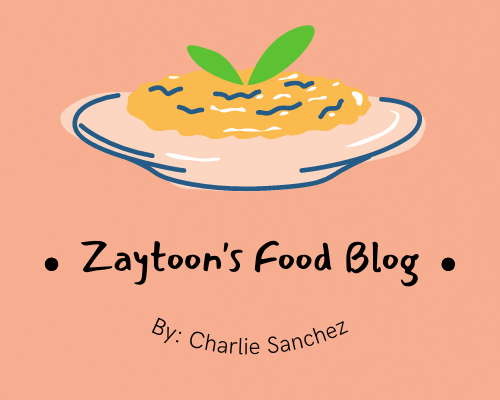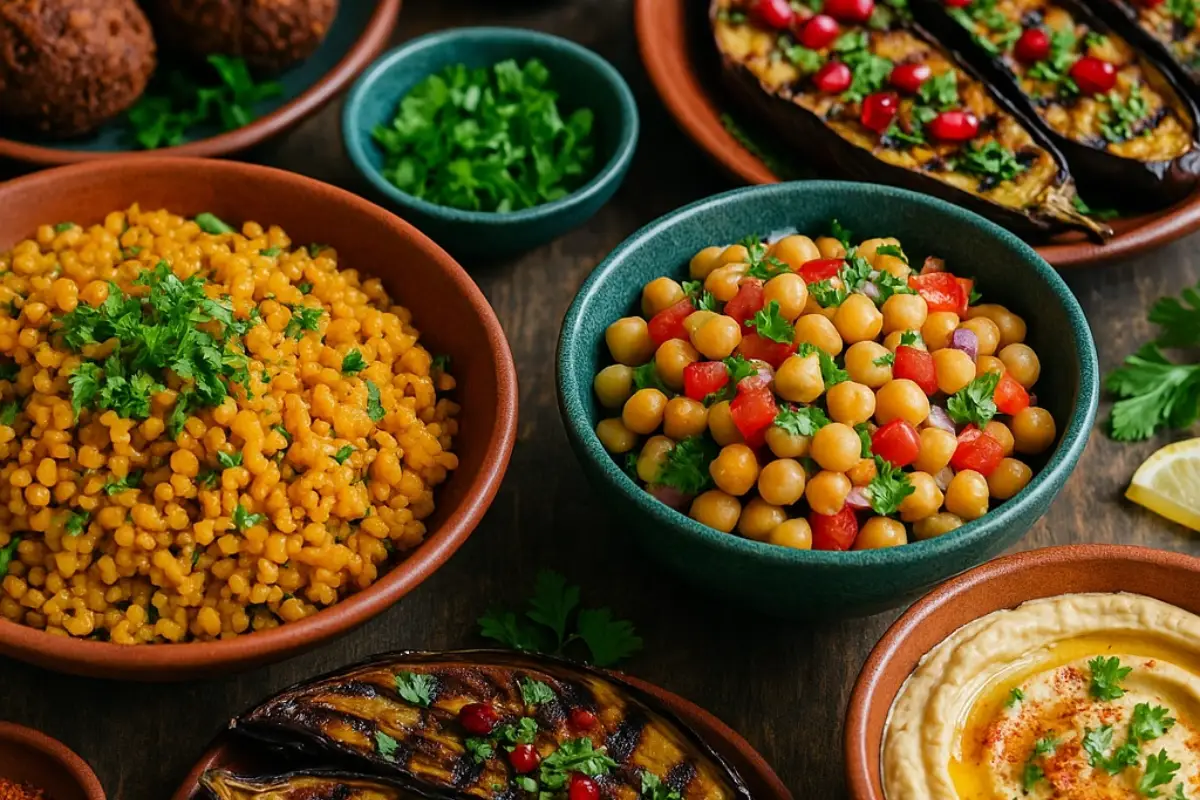Think plant-based means plain or boring? Middle Eastern food would like a word. With dishes built around lentils, chickpeas, aubergines, herbs, and spices, this cuisine has been delighting taste buds without needing animal products for centuries.
It’s bold, fragrant, and naturally vegan-friendly. They are perfect if you’re hungry for variety without the trouble.
In this post, you’ll get a taste of vegan Middle Eastern recipes that feel rich, satisfying, and full of heart. We’ll walk through breakfasts worth waking up for, mains that fill you up without slowing you down. You’ll also find fruitful tips and shortcuts to make it all doable in your kitchen.
Ready to cook food that makes you excited to eat your greens? Let’s open the pantry and get started.
The Plant-Based Pantry: What You’ll Need
Middle Eastern cooking is surprisingly pantry-friendly. With a few everyday ingredients, you can prepare flavourful, balanced meals without a sweat. Many essentials used in plant-based Middle Eastern food are already vegan by nature.
Here’s what to keep stored and how each one works in the kitchen.
Everyday Essentials
Middle Eastern kitchens rely on simple ingredients that bring depth, richness, and balance. These items are the backbone of many plant-based dishes and keep beautifully in your pantry.
- Chickpeas: These are used in everything from hummus to stews and crispy falafel. They’re protein-rich and high in fibre, which makes them a filling base for meals. Canned chickpeas are fine, but dried chickpeas offer a better texture if soaked and cooked properly.
- Lentils: A favourite in dishes like mujadara and hearty soups. Red lentils cook down to a soft, creamy texture, while brown or green hold their shape better. Packed with iron and easy to digest, they’re a budget-friendly protein source.
- Bulgur wheat: It’s a cracked wheat grain with a nutty flavour and chewy bite. It’s the star of tabbouleh and a base for stuffed vegetables and kibbeh. It cooks quickly and provides long-lasting energy from complex carbohydrates.
- Tahini: This smooth sesame seed paste adds creamy richness to sauces, dips and dressings. It’s a good source of calcium and healthy fats, and mixes beautifully with lemon and garlic.
- Za’atar: A bold mixture of thyme, sumac and sesame seeds. A pinch of flatbread, roasted veg or labneh-style dips adds an earthy, tangy kick. It’s one of the quickest ways to add a traditional twist.
- Fresh herbs: Parsley, mint and coriander bring brightness and balance to grain-heavy or legume-based dishes. Use them generously in salads, soups or as a garnish. They also support digestion and add a presentation of colour.
Vegan-Friendly Swaps
Some traditional recipes use dairy or animal-based products. However, these plant-based alternatives below keep your dishes flavourful without any compromise.
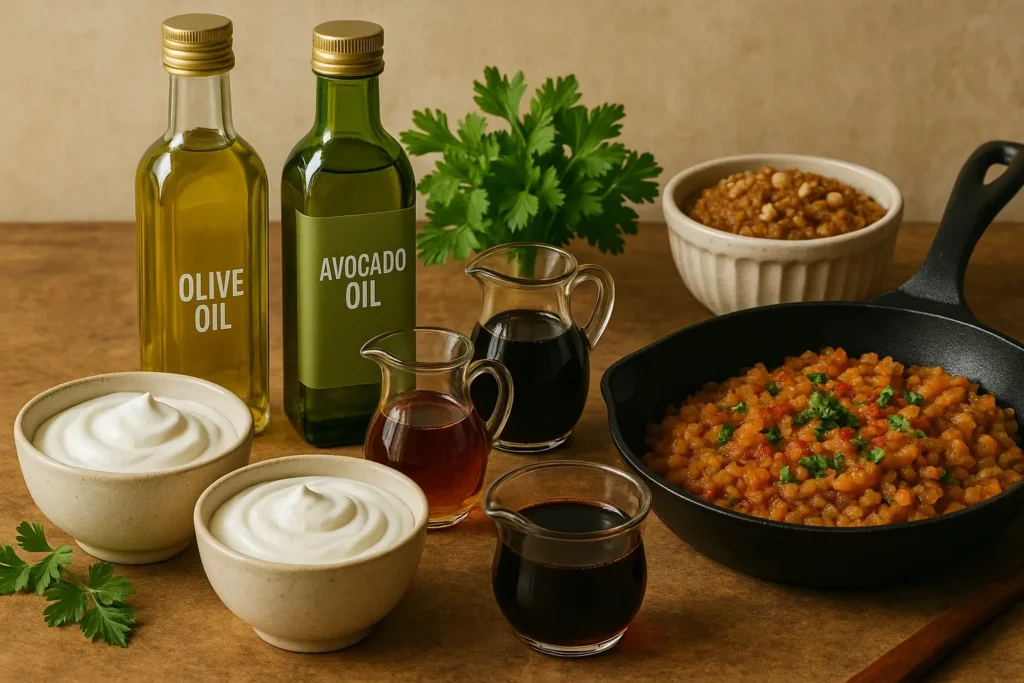
- Olive oil or avocado oil instead of butter or ghee: Olive oil works well for sautéing and dressing. And avocado oil is a good choice for high-heat cooking or when you want a neutral flavour.
- Coconut or soy yoghurt instead of Yoghurt: These swaps suit dips, sides and dressings. Coconut yoghurt gives creaminess, while soy yoghurt adds more protein to the mix.
- Maple syrup or date syrup instead of Honey: For sweet dishes, maple and date syrups provide natural sweetness with deeper flavour. They go well into sauces and desserts.
A Quick Nutrition Note: This way of cooking supports gut health, balanced energy and plant-based protein intake. Lentils and chickpeas offer iron and fibre, while whole grains like bulgur keep digestion on track. And fresh herbs are full of antioxidants. Besides being good, these ingredients help you feel good as well.
Vegan Middle Eastern Breakfasts
After getting your pantry stocked, let’s now talk about the first (and arguably best) meal of the day: breakfast. Vegan Middle Eastern breakfasts are warm, savoury and built to keep you full.
Unlike sugary cereals or toast-and-jam routines, these dishes centre on real ingredients like legumes, herbs and grains.
They’re hearty, humble and deeply satisfying. Here’s how these traditional breakfasts bring big flavour to your morning plate.
Ful Medames
Popular in Egypt and across the Levant, ful is a mashed fava bean dish often served warm with olive oil, lemon, garlic and chopped parsley. It’s earthy, rich and packed with protein. Add sliced tomatoes, fresh herbs or even pickled veg on the side for a full plate.
Drawing from our experience, this item is an ideal go-to breakfast for busy weeks. Make a big batch of ful at the start of the week and reheat portions with a splash of water and olive oil. It keeps well in the fridge and tastes even better on day two. It also pairs well with nearly anything savoury.
Musabaha
Think of this as hummus with a rustic twist. Made with whole chickpeas rather than blended smooth, musabaha is creamy yet textured. It’s spiced with cumin and served warm, drizzled with tahini sauce. You may add chilli flakes or coriander for extra depth as well.
Za’atar Flatbread with Labneh Alternative
Za’atar manakish (flatbread topped with za’atar and olive oil) is a breakfast staple in Lebanon and Syria. Pair it with a plant-based yoghurt alternative mixed with cucumber, mint and garlic for a refreshing twist on labneh.
Breakfast traditions change from country to country, but one thing stays the same: these vegan Middle Eastern recipes bring warmth, comfort and flavour to the table.
Start your day the falafel way, minus the frying guilt.
Mains That Don’t Need Meat to Impress
There’s something deeply satisfying about a main dish that holds its own without needing meat. These meals are warm and unique. They rely on various ingredient combinations instead of animal products. Yet, they don’t feel like a compromise. Rather, they feel complete.
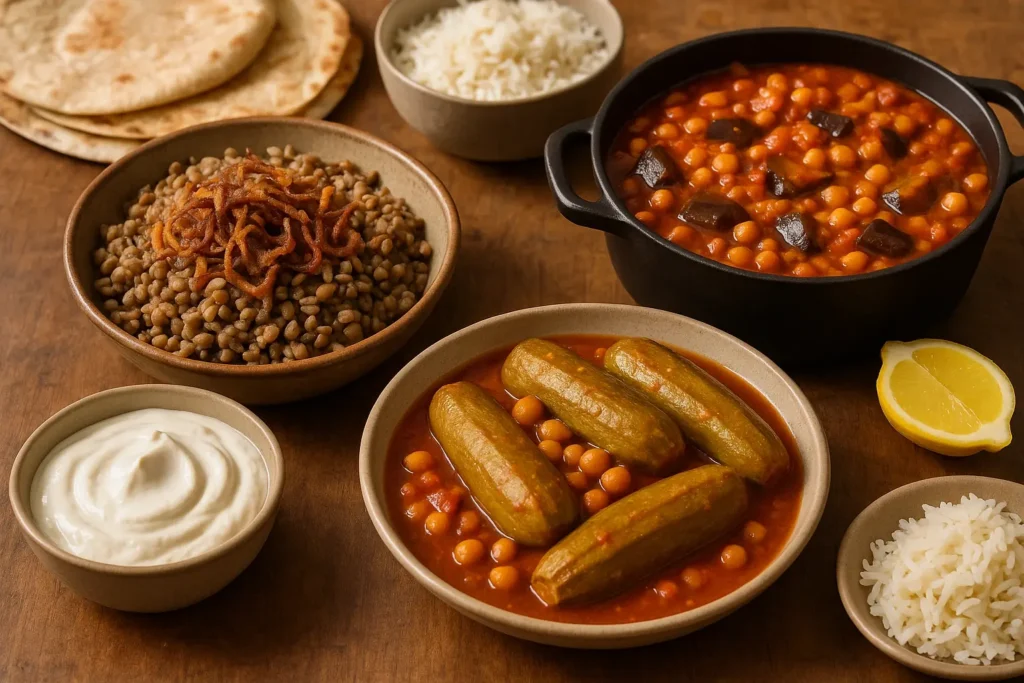
Here’s how classic meatless Arabic meals deliver the goods with zero sacrifice.
Mujadara
An integral food across the Levant, mujadara combines lentils, rice and golden crispy onions into something far greater than the sum of its parts. The lentils offer protein and iron, while the rice provides comforting bulk. And those fried onions on top are pure magic.
Rinse your rice thoroughly and cook the lentils until just tender to avoid a mushy mix. Meanwhile, let the onions cook slowly to develop that caramelised sweetness.
Maghmour
Often called Lebanese moussaka, maghmour is a tomato-based eggplant stew that is rich, spiced and filling. It is usually simmered with chickpeas, onions, garlic and warm spices like cinnamon or allspice. Serve it warm with flatbread or over rice.
Based on our experience, the trick for the best maghmour is to salt the eggplant slices before cooking. This pulls out bitterness and helps them brown nicely without soaking up too much oil.
Stuffed Zucchini (Kousa Mahshi)
Kousa mahshi features tender zucchini hollowed and filled with a mix of rice, herbs and tomatoes. It is gently simmered in a spiced tomato broth until the flavours melt together. This dish feels festive but is simple enough for a weeknight.
To master these mains, start simple and layer your spices slowly. It comes down to balance, patience and that final squeeze of lemon.
Nutrition note: These plant-based Lebanese foods naturally deliver fibre, iron and plant protein, plus loads of flavour. And because they rely on whole ingredients, you will feel full without feeling weighed down.
Mezze Mayhem: Dips, Salads and Small Plates
Mezze brings people together through food that’s colourful, diverse and packed with flavour. These small dishes are served before a meal or shared as a full spread.
In many Middle Eastern homes, mezze is a sign of generosity and hospitality. Guests are offered plenty, and no one leaves without a full plate. Many vegan Middle Eastern recipes fit seamlessly into this tradition.
With just a few core ingredients, you can create a mezze board that feels festive, fresh and satisfying.
Here’s how to build a table worth gathering around.
Hummus and Baba Ghanoush
These two dips are staples across the region. They’re creamy, comforting and come together with just a few ingredients. Both are often served with warm flatbread and always seem to disappear first.
Hummus
Made from blended chickpeas, tahini, lemon and garlic, hummus is creamy and filling. It pairs well with raw veg, falafel, or simply scooped up with fresh pita. For the best texture, use cooked chickpeas and a generous spoonful of tahini.
Baba Ghanoush
This dip is made by roasting or grilling aubergines until the skin blisters. The flesh is then mashed with tahini, lemon and garlic. The result is smoky, smooth and ideal as a side or starter.
Tabbouleh and Muhammara
These two add contrast and colour to your spread. One is fresh and herby, the other rich and slightly sweet.
Tabbouleh
Tabbouleh is made with bulgur, lots of parsley, mint, lemon juice and tomato. It’s bright and citrussy and best served cold. Finely chopping the herbs gives it that signature texture and flavour.
Muhammara
This tasty red dip mixes roasted red peppers, walnuts and pomegranate molasses. It’s earthy, tangy and slightly sweet. Some versions add breadcrumbs for thickness or chilli flakes for a bit of heat.
Yalanji and Mezze Boards
Yalanji are stuffed vine leaves filled with rice, herbs and a splash of lemon juice. They’re rolled by hand, simmered gently and served cold. A drizzle of olive oil on top brings everything together.
On the other hand, a well-rounded mezze board includes a mix of dips, salads, breads, pickles and stuffed bites. You can add olives, radishes or fresh veg for crunch. This setup works brilliantly for brunch, casual entertaining or a relaxed dinner.
Warning: You may double-dip. And that’s fine here.
Sweet Tooth? Time for Vegan Desserts
After a savoury mezze spread, dessert brings balance and satisfaction to the table. Arabic sweets are known for their richness, fragrant spices and generous use of nuts.
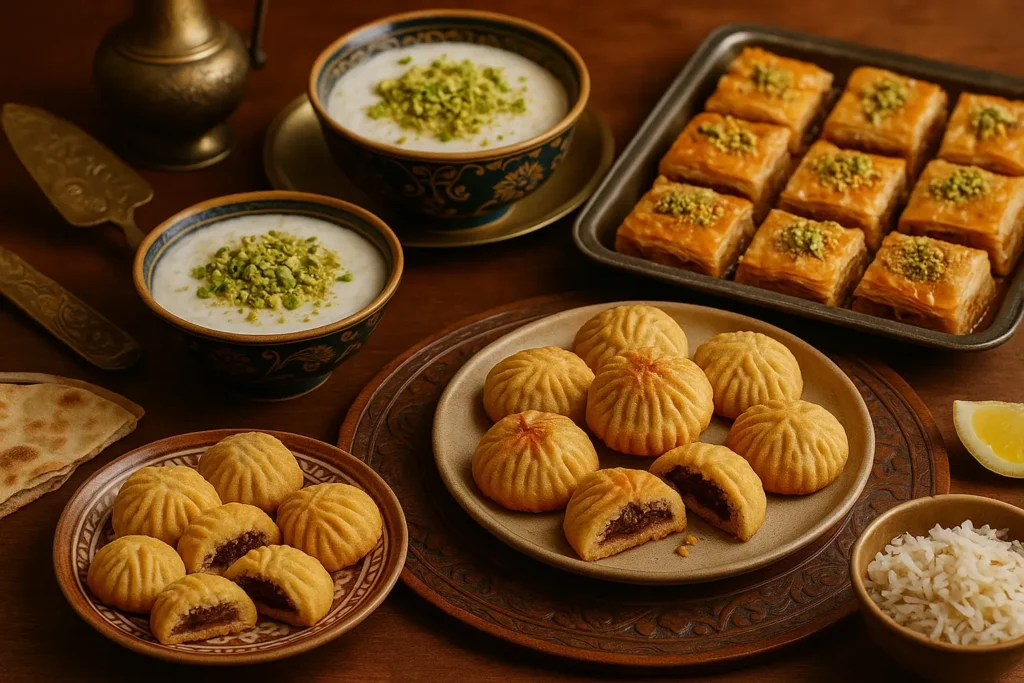
Many traditional recipes already use plant-based ingredients or can be easily adapted without losing their charm. These desserts prove that you can keep the indulgence while making simple swaps.
Let’s have a look at some excellent options:
- Date-Stuffed Ma’amoul: These soft, crumbly cookies are filled with a spiced date paste and shaped using wooden moulds. Instead of ghee, coconut oil adds a lovely texture and a light tropical note. They’re a classic treat often made for holidays and family visits.
- Baklava with Maple Syrup and Vegan Butter: Thin sheets of filo pastry layered with nuts and brushed with vegan butter create the signature crunch. Maple syrup replaces honey for a glossy finish that’s just as sweet and sticky. Let the baklava cool slightly before adding syrup to keep each layer crisp.
- Rosewater Rice Pudding with Almond Milk: This pudding is creamy, delicate and lightly scented with rosewater. Almond milk gives it a silky base without needing dairy. A sprinkle of pistachios on top adds colour and crunch.
In many households, sweets are part of the welcome. They’re served at holidays, after dinner and any time guests arrive.
Arab desserts are dramatic. Syrupy. Nutty. And possibly judging you from the tray.
Tip: Take your time with textures. Let nuts cool before chopping, and always add syrup after baking.
Nutritional Benefits of Meatless Arabic Meals
Plant-based cooking in the Arab world is anything but nutritionally empty. Many of the most-loved dishes depend on iron-rich lentils, protein-packed chickpeas and anti-inflammatory ingredients like garlic, parsley and olive oil. These meals offer both comfort and health in every bite.
One of the most common myths is that meatless Arabic meals are all carbs and no substance. But that is far from reality. Mujadara, for example, brings together protein, fibre and iron in one pot. Ful medames offers a slow-digesting, protein-rich breakfast. And if you add sides like tabbouleh or baba ghanoush, you are eating a range of vitamins and healthy fats without even trying.
Research on the Mediterranean diet often highlights the benefits of many of these same ingredients. They support lower inflammation, better heart health and sustained energy.
These recipes are time-tested traditions supported by generations of lived experience and now, science as well. Turns out your grandmother’s lentil stew was practically a multivitamin in disguise.
Let’s now look at how to make these meals even easier with beginner-friendly tips.
Beginner-Friendly Recipe Tips
Cooking Middle Eastern food for the first time can feel a bit intimidating, but once you’ve got a few basics down, it becomes enjoyable and surprisingly relaxed. The right spices, simple methods and a bit of planning can encourage anyone to create flavourful, plant-based meals with confidence.
Here is a guideline to begin:
- Start with five core spices: Cumin, cinnamon, sumac, allspice and paprika are a great starting point. They cover most traditional flavour profiles and are easy to find at any local shop.
- Avoid overcooked pulses and tasteless veg: Lentils should be soft but still hold their shape. Eggplant benefits from salting before roasting to remove bitterness and improve texture. Always season in layers and taste as you go.
- Batch cook for easy meals: Prepare a large portion of lentils or chickpeas, a lemony tahini sauce and a herb mix with parsley and mint. These components can be reused across multiple dishes throughout the week.
- Try a 3-day beginner plan: Day 1 for Mujadara with tabbouleh, Day 2 for Ful medames with flatbread and pickled onions, and Day 3 for stuffed zucchini with tahini and a crisp salad.
These simple steps make daily cooking less stressful and more enjoyable.
Cultural Aspect of Vegan Middle Eastern Dishes
Food plays a role in Middle Eastern daily routines, celebrations and moments of reflection. Generosity, hospitality and storytelling are often shared over a plate of something warm and fragrant.
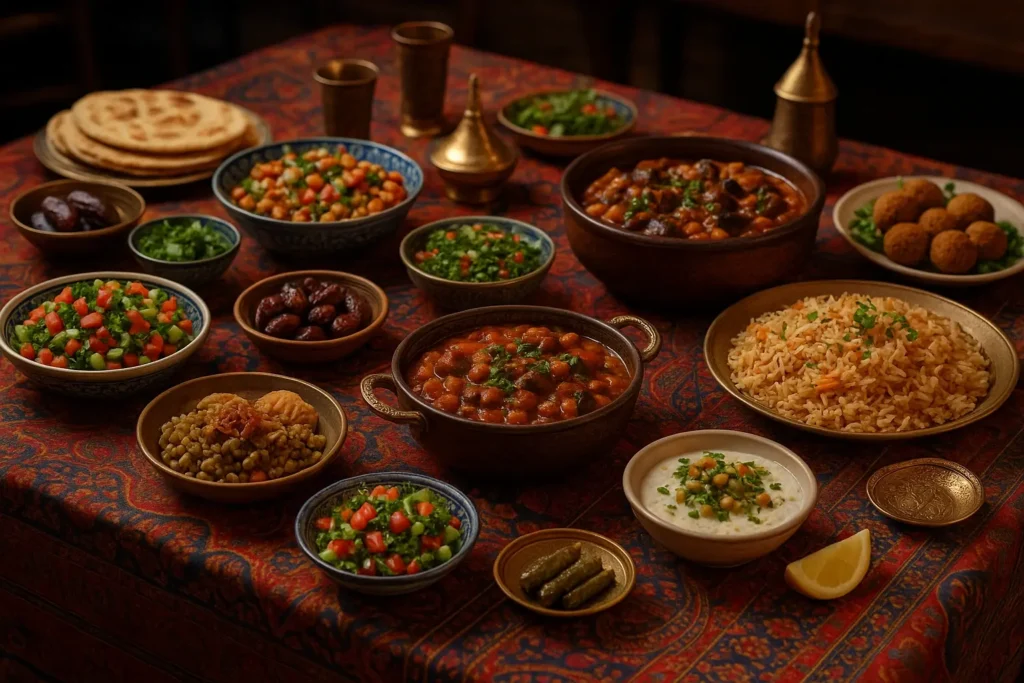
Learning the traditions behind these vegan Middle Eastern recipes adds meaning to the experience of cooking and eating them.
Ramadan and Daily Rituals
During Ramadan, meals are prepared with extra care. The day ends with iftar, where family and friends gather to share lentil soup, dates, fresh salads and slow-cooked dishes. Outside of Ramadan, meals remain a time to pause, connect and show care through what is on the table.
Weddings and Celebrations
Weddings, holidays and family gatherings call for large spreads and lots of sharing. Food is prepared in generous portions and often cooked as a group effort during these occasions. Meanwhile, offering your best dish is seen as a sign of respect, and no guest leaves hungry.
Cooking these meals invites you to take part in a long-standing tradition.
Your Next Plant-Based Feast Starts Here
Middle Eastern food can offer comfort, depth and flavour without relying on meat or dairy. Throughout this guide, we’ve walked through warm breakfasts like ful medames, hearty mains such as mujadara and maghmour, vibrant mezze spreads and sweet finishes like rosewater rice pudding.
Each dish brings something unique to the table, offering nutrition, tradition and bold taste.
Vegan Middle Eastern recipes ensure that everyday meals feel generous and nourishing. These recipes use simple ingredients in clever ways to create something satisfying and memorable.
If you’re exploring plant-based living or just want to bring new flavours into your kitchen, these dishes are an excellent place to begin.
For more recipes, stories and step-by-step guides, visit us at Zaytoon’s Food Blog. The site is a celebration of Middle Eastern home cooking. Try a recipe, share it with friends and be a part of the journey.
